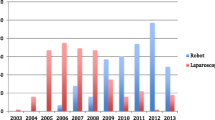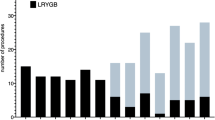Abstract
Background
Laparoscopic Roux-en-Y gastric bypass is one of the most commonly performed bariatric operation worldwide for the surgical management of obesity. Totally robotic Roux-en-Y gastric bypass (TR-RYGBP) has been considered to be a better approach by some groups especially early in a surgeon's experience. However, the learning curve associated with TR-RYGBP has been poorly evaluated yet. The aim of this study was to evaluate the learning curve of patients who underwent TR-RYGBP.
Methods
This is a prospective study of 154 first consecutive patients undergoing TR-RYGBP to analyze the influence of surgeon experience, bedside first assistant, and patient factors on operative time and postoperative complications. To give a comprehensive view of success related to the learning process, a single hybrid variable was generated. Multivariate analysis predicted the risk factors for complications and operative time. A risk-adjusted cumulative sum analysis estimated the learning curve.
Results
The learning curve for TR-RYGBP was 84 cases. Case rank and first assistant level were independent predictors of total operative time. Overall 30-day postoperative morbidity rate was 33.1 % and decreased over time. Surgeon experience (OR 2.6; CI 95 [1.290 to 5.479]; p = 0.0081) and first assistant level (OR 2.42; CI 95 [1.197 to 4.895]; p = 0.0139) remained independent predictors of composite event (operative time and complications).
Conclusions
This study identifed criteria that should be assessed in future studies about TR-RYGBP. Both surgeon experience and bedside first assistant level affected operative duration, but surgeon experience was the most significant factor in reducing complication rates.



Similar content being viewed by others
References
Zevin B, Aggarwal R, Grantcharov TP. Simulation-based training and learning curves in laparoscopic Roux-en-Y gastric bypass. Br J Surg. 2012;99:887–95.
Iordens G, Klaassen R, Van Lieshout E, et al. How to train surgical residents to perform laparoscopic Roux-en-Y gastric bypass safely? World J Surg. 2012;36:2003–10.
Livingston EH. The incidence of bariatric surgery has plateaued in the U.S. Am J Surg. 2010;200:378–85.
National Institutes of Health (NIH). Gastrointestinal surgery for severe obesity. NIH Consens Statement Online. 9:1-20 1991 Mar 25-27 [cited 2012 January 8]; available at: http://consensus.nih.gov/1991/1991gisurgeryobesity084html.htm.
Puzziferri N, Austrheim-Smith I, Wolfe B, et al. Three-year follow-up of a prospective randomized trial comparing laparoscopic versus open gastric bypass. Ann Surg. 2006;243:181–8.
Haute Autorité de Santé (HAS). French guidelines for morbid obesity surgery. 2009 [cited 1 janvier 2012]; Available from: http://www.hassante.fr/portail/jcms/c_765529/obesite-prise-en-charge-chirurgicale-chez-l-adulte.
Buchs NC, Pugin F, Bucher P, et al. Learning curve for robot-assisted Roux-en-Y gastric bypass. Surg Endosc. 2012;26:1116–21.
The Fellowship Council. Guidelines for the Fellowship Council Accredited Fellowships in Surgery. Updated April 2012 [cited May 2012]; Available at: http://fellowshipcouncil.org/wp-content/uploads/2012/02/Accreditation-Updated-Guidelines-and-Definitions-Final-for-Web-April-2012.pdf.
Zevin B, Aggarwal R, Grantcharov TP. Volume–outcome association in bariatric surgery. A systematic review. Ann Surg. 2012;256:60–71.
Sanchez BR, Mohr CJ, Morton JM, et al. Comparison of totally robotic laparoscopic Roux-en-Y gastric bypass and traditional laparoscopic Roux-en-Y gastric bypass. Surg Obes Relat Dis. 2005;1:549–54.
Tieu K, Allison N, Snyder B, et al. Robotic-assisted Roux-en-Y gastric bypass: an update from two high volume centers. Surg Obes Relat Dis. 2013;9:284–8.
Benizri E, Renaud M, Reibel N, et al. Perioperative outcomes after totally robotic gastric bypass: a prospective non-randomized controlled study. Am J Surg. 2013. doi:10.1016/j.amjsurg.2012.07.049.
Hubens G, Balliu L, Ruppert M, et al. Roux-en-Y gastric bypass procedure performed with the da Vinci robot system: is it worth it? Surg Endosc. 2008;22:1690–6.
Mohr CJ, Nadzam GS, Alami RS, et al. Totally robotic laparoscopic Roux-en-Y gastric bypass: results from 75 patients. Obes Surg. 2006;16:690–6.
Park CW, Lam EC, Walsh TM, et al. Robotic-assisted Roux-en-Y gastric bypass performed in a community hospital setting: the future of bariatric sugery? Surg Endosc. 2011;25:3312–21.
Yu SC, Clapp BL, Lee MJ, et al. Robotic assistance provides excellent outcomes during the learning curve for laparoscopic Roux-en-Y gastric bypass: results from 100 robotic-assisted gastric bypasses. Am J Surg. 2006;192:746–9.
Bolsin S, Colson M. The use of the CUSUM technique in the assessment of trainee competence in new procedures. Int J Qual Health Care. 2000;12:433–8.
Poloniecki J, Valencia O, Littlejohns P. Cumulative risk adjusted mortality chart for detecting changes in death rate: observational study of heart surgery. BMJ. 1998;6:1697–700.
Ziegler O, Sirveaux MA, Brunaud L, et al. Medical follow up after bariatric surgery: nutritional and drug issues. Diabetes Metab. 2009;35:544–57.
Olbers T, Fagevik-Olsen M, Maleckas A, et al. Randomized clinical trial of laparoscopic Roux-en-Y gastric bypass versus laparoscopic vertical banded gastroplasty for obesity. Br J Surg. 2005;92:557–62.
Germain A, Reibel N, Brunaud L. Totally robotic gastric bypass. J Visc Surg. 2011;148:e267–72.
Dindo D, Demartines N, Clavien PA. Classification of surgical complications. Ann Surg. 2004;240:205–13.
Bege T, Lelong B, Esterni B, et al. The learning curve for the laparoscopic approach to conservative mesorectal excision for rectal cancer. Ann Surg. 2010;251:249–53.
Grunkemeier GL, Wu YX, Furnary AP. Cumulative sum techniques for assessing surgical results. Ann Thorac Surg. 2003;76:663–7.
Noyez L. Control charts, CUSUM techniques and funnel plots. A review of methods for monitoring performance in healthcare. Interact Cardiovasc Thorac Surg. 2009;9:494–9.
Sudan R, Bennett K, Jacobs D, et al. Multifactorial analysis of the learning curve for robot-assisted laparoscopic biliopancreatic diversion with duodenal switch. Ann Surg. 2012;255:940–5.
Mohr CJ, Nadzam GS, Curet MJ. Totally robotic Roux-en-Y gastric bypass. Arch Surg. 2005;140:779–86.
Snyder BE, Wilson T, Leong BY, et al. Robotic-assisted Roux-en-Y gastric bypass: minimizing morbidity and mortality. Obes Surg. 2010;20:265–70.
Ayloo SM, Addeo P, Buchs NC, et al. Robot-assisted versus laparoscopic Roux-en-Y gastric bypass: is there a difference in outcomes? World J Surg. 2011;35:637–42.
Scozzari G, Rebecchi F, Millo P, et al. Robot-assisted gastrojejunal anastomosis does not improve the results of the laparoscopic Roux-en-Y gastric bypass. Surg Endosc. 2011;25:597–603.
Addeo P, Buchs N. Robotic and laparoscopic gastric bypass: are they comparable? Surg Endosc. 2012;26:576–7.
Richards W. Is robotic-assisted Roux-en-Y gastric bypass better than laparoscopic gastric bypass? Surg Obes Relat Dis. 2012. doi:10.1016/j.soard.2012.01.005.
Brunaud L, Ayav A, Zarnegar R, et al. Prospective evaluation of 100 robotic-assisted unilateral adrenalectomies. Surgery. 2008;144:995–1001.
Buchs NC, Pugin F, Chassot G, et al. Robot-assisted Roux-en-Y gastric bypass for super obese patients: a comparative study. Obes Surg. 2013;23:353–7.
Vonlanthen R, Slankamenac K, Breitenstein S, et al. The impact of complications on costs of major surgical procedures. Ann Surg. 2011;254:907–13.
Chandra V, Nehra D, Parent R, et al. A comparison of laparoscopic and robotic assisted suturing performance by experts and novices. Surgery. 2010;147:830–9.
Chang L, Satava M, Pellegrini A, et al. Identifying the learning curve through objective measurement of skill. Surg Endosc. 2003;17:1744–8.
Narazaki K, Oleynikov D, Stergiou N. Robotic surgery training and performance. Surg Endosc. 2006;20:96–103.
Conflict of Interest
N Reibel received support for teaching and research in the institution through Ethicon Endosurgery. L Bresler is a proctor (robotic rectopexy) for Intuitive Surgical. Other authors declare that they have no conflict of interest.
Author information
Authors and Affiliations
Corresponding author
Rights and permissions
About this article
Cite this article
Renaud, M., Reibel, N., Zarnegar, R. et al. Multifactorial Analysis of the Learning Curve for Totally Robotic Roux-en-Y Gastric Bypass for Morbid Obesity. OBES SURG 23, 1753–1760 (2013). https://doi.org/10.1007/s11695-013-1020-1
Published:
Issue Date:
DOI: https://doi.org/10.1007/s11695-013-1020-1




